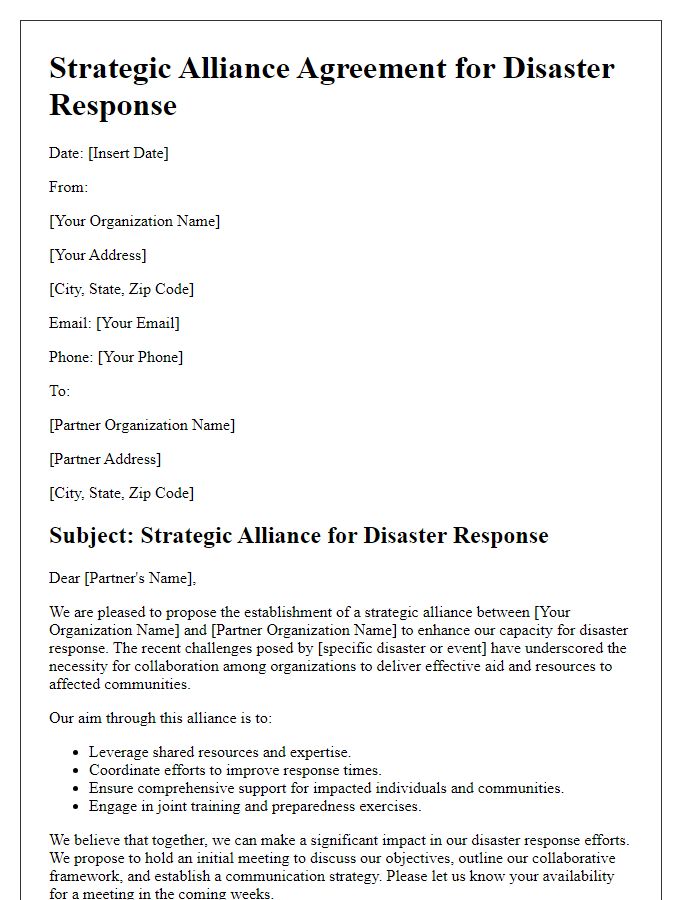Are you ready to take action when disaster strikes? In our ever-changing world, being prepared for emergencies is more crucial than ever, and collaboration can significantly increase our readiness and resilience. By working together, we can share resources, knowledge, and strategies that will ensure our communities are equipped to handle any situation. Join us as we explore the importance of disaster preparedness collaboration and discover ways you can get involved!

Clear objectives and intentions
Disaster preparedness collaboration efforts aim to enhance community resilience against natural catastrophes, such as hurricanes, earthquakes, and floods. Clear objectives involve establishing coordinated communication channels among local authorities, emergency services, and non-profit organizations, ensuring that resources such as food, water, and medical supplies are readily available and equitably distributed during emergencies. Intentions include conducting regular training exercises in high-risk areas, educating the public on safety protocols, and developing comprehensive evacuation plans that account for vulnerable populations. Effective collaboration also emphasizes the importance of fostering partnerships between government agencies and community groups to implement sustainable recovery strategies that strengthen infrastructure and improve overall readiness for future disasters.
Specific roles and responsibilities
The establishment of effective disaster preparedness collaboration involves clearly defined roles and responsibilities among stakeholders. Local emergency management agencies, such as the Federal Emergency Management Agency (FEMA) in the United States, are responsible for developing and implementing disaster response plans. Community organizations, such as the American Red Cross, are tasked with providing immediate humanitarian assistance, including shelter and food during emergencies. Public health departments, such as the CDC, play a crucial role in preparing for and responding to health crises, ensuring that vaccination and health literacy programs are in place before disasters strike. Additionally, local authorities, like city managers and mayors, coordinate resources and communication efforts in their jurisdictions, ensuring the flow of information to citizens about available services and emergency protocols. Volunteers from organizations like Team Rubicon contribute valuable skills and manpower during disasters, while private sector partners provide essential resources, technology, and infrastructure support. Regular training sessions and simulations, such as those conducted through the National Incident Management Assistance Teams (IMAT), help ensure all parties are equipped to act effectively and efficiently during a disaster situation.
Contact information and communication plan
Effective disaster preparedness collaboration requires a clear communication plan. Begin by establishing a designated contact list that includes emergency coordinators, local authorities, and community organizations involved in disaster response, such as the Red Cross and FEMA (Federal Emergency Management Agency). Utilize communication tools like WhatsApp groups or emergency alert systems to ensure rapid dissemination of critical information, especially during disasters such as hurricanes or earthquakes. Regular training sessions should be organized to familiarize all parties with the communication protocols, enhancing the cooperation between emergency services and community support teams. Practicing scenario-based drills, like the Great ShakeOut earthquake drills for earthquake preparedness, can improve responsiveness and effectiveness. Timely updates on resources, evacuation routes, and shelter information must be communicated through various channels, including social media and local news outlets, ensuring information reaches all community members efficiently.
Resource allocation and logistics
Disaster preparedness collaboration focuses on resource allocation and logistics to ensure effective response during emergencies. Effective resource allocation involves identifying critical supplies such as food, water, medical kits, and shelter materials, crucial for disaster-stricken areas like Hurricane-prone regions in Florida or wildfires in California. Strategic logistics planning facilitates the timely delivery of these supplies, optimizing transport routes based on real-time data from events like earthquakes or floods. Collaboration between local governments, NGOs, and federal agencies enhances both planning and execution phases during drills or actual disasters, ensuring communities are resilient in the face of adversity. Comprehensive training programs and simulations can improve communication and coordination, essential for efficient emergency response operations.
Emergency response protocols and procedures
Disaster preparedness involves establishing comprehensive emergency response protocols and procedures to enhance community resilience. Local agencies (such as fire departments and rescue organizations) collaborate with governmental bodies (like the Federal Emergency Management Agency, FEMA) to create detailed plans that outline steps for various disaster scenarios, including hurricanes, earthquakes, and flooding. Critical components include communication protocols that specify key contacts and information dissemination methods to alert citizens of imminent threats. Training exercises, such as community drills held annually in cities like New Orleans, ensure readiness by simulating real-life situations and testing response effectiveness among participating organizations. Resource allocation strategies are also crucial, detailing the distribution of essential supplies such as food, water, and medical aid during crises. Overall, ongoing partnerships and clear guidelines are vital for implementing effective disaster response initiatives.













Comments